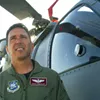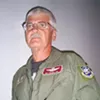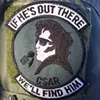It has been a quiet deployment. Maj. Jeff Peterson passes the daytime hours sleeping in his hooch in Kandahar, and at night, he stays awake "holding the brick"—his alert radio—waiting for a call.
The job of the 305th Rescue Squadron, based at Davis-Monthan Air Force Base, is to pick up downed airmen. That's usually not a problem in Afghanistan, because Americans own the night.
The squad occasionally retrieves wounded soldiers the Army can't get to because of weather or darkness. Or they evacuate Afghanis hurt in car wrecks. But the kinds of missions the 305th trained for haven't happened.
They've been in Afghanistan almost six weeks. They've never taken enemy fire. In three days, they're going home.
An urgent voice comes over Peterson's "brick." It's about 11 a.m. the morning of June 30, 2005.
Peterson suspects something big. The night before, his crew had watched a CNN report about the crash of a Chinook helicopter in northern Afghanistan.
"The only thing they told us was, 'Pack a three-day bag. You're going up north,'" says Peterson.
Events over the next three days would land Peterson and his five-man Tucson crew at the center of an episode that continues to garner worldwide attention.
The 305th, part of the 920th Rescue Wing, is being sent to pick up Navy SEAL Marcus Luttrell, one of a four-man team ambushed by 150 Taliban fighters. Three of the SEALs are killed.
When a Chinook responds to their desperate call for help, a rocket-propelled grenade brings the chopper down, killing 16 more men.
Luttrell goes on to write Lone Survivor: The Eyewitness Account of Operation Redwing and the Lost Heroes of Seal Team 10.
The book is a best-seller in 2007. Universal Pictures is in production on a movie for likely release in 2010. The director will be Peter Berg of Friday Night Lights.
London-based Windfall Films has produced a documentary, Helicopter Wars, describing four extreme wartime helicopter missions, including the Luttrell rescue. It has already aired in Great Britain and Australia, and is expected to air in the United States in the coming months.
With the Afghan war back in the headlines, and none of the news good, the rescue provides a glimpse into one story that began horribly and ended well, thanks to the ordinary Americans who made it happen.
Peterson's crew includes his 57-year-old flight engineer, a former Pima County sheriff's deputy, silver haired, sometimes cantankerous, sometimes a joker, cool under pressure.
His gunner is a nervous University of Arizona student. The co-pilot is a skinny, 40-year-old seasoned by thousands of hours flying a Blackhawk along the Arizona-Mexico border for the Border Patrol. But he carries rosary beads in his pocket just in case.
Peterson himself looks like a fifth-grade math teacher. He stands 5 foot 8, has a stout build, sprinkles of gray in his hair and goes by the nickname "Spanky," after the angel-faced kid in the Little Rascals comedies. He married his college sweetheart six months before graduating from Arizona State University in 1991.
They're the kind of fellows you might run into in the checkout line at Safeway. Everyday guys. Air Force reservists. But when their moment came, they rose to meet it.
"People have called us heroes," says Peterson, "but I don't think of it that way."
His voice trails off as he thinks back to that dark night in northeastern Afghanistan. A minute of private recollection passes before he shakes his head in wonder.
"Sometimes, I still can't believe we pulled this thing off," Peterson says.
Operation Redwing goes south fast. The SEALs' mission is to capture or kill a Taliban leader responsible for lethal bomb attacks on U.S. Marines.
But shortly after the SEALs rope down from a Chinook into enemy territory, they're discovered by three Afghan villagers herding goats.
The Americans face an agonizing choice: Release the Afghanis and trust they won't tell the Taliban about the soldiers, or eliminate the risk by executing the villagers, one a teenage boy.
The SEALs take a vote, and it comes down to Luttrell's call. Even though he knows he might be signing his team's death warrant, he votes to turn the Afghanis loose.
Every night since then, Luttrell has awakened in a cold sweat from the choice he made, feeling the agony of its consequences.
"I'll never get over it. I cannot get over it," he writes in Lone Survivor. "The deciding vote was mine, and it will haunt me (until) they rest me in an East Texas grave."
The goatherds alert the Taliban, and within 90 minutes, the Americans are battling for their lives. Luttrell describes the four SEALs blasting away at Taliban fighters swarming over the ridge above them.
But every time the SEALs shoot them down and clear the ridge, more come to take their place. "Never even for a couple of seconds was there a lull in the gunfire," Luttrell writes. He called it the Little Bighorn with Taliban.
The battle ends with the deaths of Lt. Michael Murphy, later awarded the Medal of Honor, and Petty Officers Danny Dietz and Matthew Axelson. Luttrell survives when a rocket-propelled grenade blows him hundreds of feet down the mountain, depositing him so far away that the Taliban fighters are unable to find him.
Now command is picking up a clicking sound on a rescue radio frequency.
It might be one or more of the SEALs, or survivors from the downed rescue Chinook. At the time, the brass didn't know everyone on board the Chinook had been killed.
Peterson and his crew, led by another chopper from the 920th under Lt. Col. Jeffrey Macrander, eventually make their way to a Marine camp in Jalalabad, on the Pakistani border.
Their orders are to wait through the night to see if the clicking returns.
At 4 a.m. on July 1, there it is again—the clicking.
The sound is coming from a 2-kilometer area near the crash site, 7,000 feet up in the Hindu Kush mountains, a no-man's land of granite peaks, sheer rock walls and plunging canyons that some believe shelter Osama bin Laden.
Peterson and Macrander climb into their HH-60 Pave Hawk helicopters, a version of the Blackhawk, and begin to search.
It's 4:30 a.m.
But are they looking for Americans, survivors? Or is this a trap by the Taliban to draw in another chopper and blow it out of the sky?
The Pave Hawks orbit the target area, pleading on their radios for the clicker to reveal his position.
Show yourself. We're here to pick you up. This is Air Force Rescue. If you're out there, please show yourself.
Unknown to the rescuers, as The Washington Post reported in 2007, Luttrell can hear the choppers circling overhead.
But the RPG explosion has ripped his pants off; his body is riddled with shrapnel; his nose and three vertebrae are broken; and dirt clogs his throat, leaving him unable to speak.
The Post described Luttrell lying in the dirt beneath the choppers mouthing a silent plea. Hey, I'm right here.
At 6:30 a.m., dawn breaks, leaving Peterson and Macrander vulnerable to Taliban fire. And they're running out of gas.
On his radio, Peterson calls down to the survivor, telling him they have to leave. "We had to bingo out," he says. "I'm saying, 'Sorry, dude, but we're out of gas.'"
On the short flight back to Jalalabad, Peterson and Macrander fight a sick feeling. They strongly suspect that one or more wounded Americans are out there somewhere, badly in need of help. But they can't find him.
Early next morning, an elderly Afghani man arrives at a small Marine camp about 8 miles from the Chinook crash site. He's carrying a note written by Luttrell.
He says men from his village, Sabray, found the wounded American, and following a Pashtun tribal custom, they now consider him their responsibility. They've taken Luttrell to Sabray and are protecting him against a swarm of Taliban soldiers.
When the villager's story is confirmed, the Americans have the break they need. They know the clicking is coming from one man, the missing SEAL, and they know exactly where he is.
But they'll have to fly into hostile Taliban country to get him out.
Their first plan calls for a big Chinook to land and wait for an already-inserted 20-man Special Forces team to grab Luttrell; then everyone runs on board for a quick getaway. Peterson and Macrander will stay back, ready to pick up possible casualties from enemy fire or a crash.
But that changes with new intelligence about another American soldier in a village 10 kilometers from Sabray. Now, after grabbing Luttrell, the Special Forces will hike off to investigate that report, making the big Chinook unnecessary.
The operation commander is a full-bird colonel, himself a former SEAL. He's dressed in fatigues, has a sharp jaw and the lean, hard body of an outside linebacker.
He turns to Peterson and Macrander and says, "Sixties, you've got the pickup."
Minutes later, Macrander tells Peterson that his chopper will be the one that actually lands and grabs Luttrell, while he, Macrander, flies cover.
Now this father of four boys—who spends much of his free time with his wife, Penny, hauling the kids to sporting events around Tucson—is one of the key players in one of the largest wartime rescues since Vietnam.
His heart rate jumps. He begins to sweat. He thinks of all the training exercises he's done in the desert outside of Tucson.
"But this was for real," says Peterson, then 39. "This was the dance. All I kept thinking was, 'You can't screw this up.'"
The night of July 2 is moonless and extremely dark. Macrander and Peterson fly toward the target, keeping their choppers low, never more than 200 feet above the ground.
Except for the green glow of their rooftop position lights, they're flying black.
Peterson's crew stays mostly silent, each lost in his own thoughts amid the drone of the chopper's engines.
Co-pilot Dave Gonzales, the Border Patrol man, is thinking about the landing zone. He's seen satellite photos. They don't give a 3-D image, but it looks big enough.
"I'm thinking this is going to be a piece of cake," he says.
Peterson worries his chopper might be too heavy. He'll need maneuverability, and he's not sure he can make a safe landing in the thin air above 7,000 feet.
He decides to dump fuel. He's directly above a river valley full of farm fields and houses. He considers breaking off and dumping in an unpopulated place, but he might not be able to return to find Macrander again in the pitch-black night.
He flips open the cover on his dump switch, saying aloud, "This is for Penny and the boys," and sends 500 pounds of gas pouring from his chopper, probably souring the dreams of Afghanis who sleep on their rooftops on warm summer nights.
"I'm sure I doused some people," Peterson says. "But now I had a weight cushion I was comfortable with."
The choppers begin their ascent of the Hindu Kush, flying through the narrow canyons that curve up rapidly toward the invisible sky.
Nearing the target, the radio chatter becomes more frequent and more urgent.
Josh Appel, an elite pararescue jumper (also called a PJ), the Air Force version of a SEAL, doesn't like what he's hearing.
Known enemy sighted 100 meters north of the position. ... Known enemy sighted 100 meters south of the position.
At the time, Appel had just graduated from the UA College of Medicine.
"I'm thinking, 'There's no way they're going to send us into this,'" he says.
This is the dance. Peterson can see it as his Pave Hawk approaches Sabray.
An AC-130 Spectre gunship and two A-10 fighter jets are lighting up the night, dropping everything they have on Taliban positions on the mountain.
Through the pilots' night-vision goggles, the explosions look like green lightning.
"It was the Fourth of July out there," Peterson says.
Appel sees it, too, saying, "Lights, explosions, tracer fire—it looked like a Hollywood movie."
It's 11:30 p.m. The radio voices are much louder now, almost shouting.
Peterson can see the strobe lights on the helmets of Special Forces soldiers around the village. But he can't see the landing zone.
"I mean, it was butt-ass dark," he says.
Prior to leaving Bagram Airfield, the Spectre pilot had agreed to shine his infrared lantern on the landing zone to help Peterson locate it. But the so-called "laser burn" isn't working. The Spectre is above the clouds, and the infrared illuminates the clouds, not the landing zone below.
The Spectre pilot's frantic voice screams over Peterson's radio: "Halos! Halos! Negative burn! Negative burn!"
The flight leader of the A-10s hears the commotion on his radio and asks his wingman to mark the landing zone with his infrared laser.
Peterson describes it as "a flashlight from God."
"It was a beam of warm light coming out of the sky, like somebody saying, 'Hey, idiot, this is where you land,'" says Peterson. "It went away after five or six seconds, but that was enough."
Peterson brings his nose up and starts the approach.
In the back, Mike Cusick, the 57-year-old flight engineer, looks out his gunner's window and sees the top of a house looming a few feet below. The descending chopper just misses it.
The village sits on a steep mountainside layered with terraces. The landing zone is one of those terraces. A wall borders it on one side, and a cliff with a 1,500-foot drop-off is on the other. The margin is holy-smokes thin, maybe 10 feet on both sides of the rotors.
"I wouldn't try this landing at home, during the day," Peterson says.
But so far, the plan is working.
The landing zone has been lasered. Macrander has dropped a glow stick on it, too, intended to provide further light, and now he's orbiting to cover Peterson if the Taliban open fire.
The ordnance raining down from the American aircraft keeps the enemy in their holes.
"I'm sure there were bad guys watching all this," says Macrander. "But if you're Taliban, you're more worried about an A-10 dropping a bomb on your head than a helicopter flying overhead."
Peterson is confident he can put his Pave Hawk down.
Then ... nightmare time.
Ten feet from the ground, the rotors kick up a storm of dust, sending Peterson into a total brownout. He can't see the wall, the ground, the cliff, anything.
Cusick is struggling as well. "For a couple of seconds, I had a touch of vertigo looking down at the terraces going down off the cliff," he says. "It was pretty disconcerting. But I got it back together."
The chopper drifts toward the rock face. Cusick and UA student Ben Peterson, the gunner, both have enough visibility to see the danger.
They shout, "Stop left! Stop left!"
Pilot Peterson pushes his control stick right. Co-pilot Gonzales lays a hand against his control stick, which is connected to Peterson's, keeping the chopper from going too far toward the ledge.
Peterson credits the experienced Gonzales, who used to fly Cobra gunships for the Army, for his split-second reaction.
"He knew instinctively I might overcompensate and go too hard right, sending us careening off the cliff," says Peterson.
Gonzales credits Peterson with keeping his concentration amid great difficulty.
"Spanky went from being able to see, to not being able to see, to listening to guys in back who could see," says Gonzales. "His workload increased dramatically."
As Peterson maintains his hover, everything moves in slow motion. He fears his rotors will hit the wall and shear off, and rescuers will have to recover his body and those of his crew.
"I thought all was lost," says Peterson. "It was a dreadful feeling."
Appel and Chris Piercecchi, the other PJ, lie down in the back of the chopper and grab whatever they can, bracing for a crash.
Peterson desperately needs a reference point. As the dust settles just enough, he sees in the distance what looks like a hanging plant. It appears to be suspended over the terrace, blowing in the wash of his rotors.
It reminds Peterson of his mom's porch in Logan, Utah, and the plants she kept there, draped with greenery. The "hanging plant"—likely a clump of drooping grass, he says now—provides a crucial reference, something to gauge left and right, up and down.
It's all he needs. He puts the chopper down two feet from the cliff's edge.
They're on the ground for about 50 seconds, an eternity when you're waiting to be vaporized by a grenade.
Appel and Piercecchi, now a UA medical student, leap from the chopper. They struggle to get oriented in the darkness, the swirling dust, the tremendous noise.
They spot two people approaching from the rear, which you're not supposed to do because of the spinning tail rotor. One is Luttrell, the other Mohammed Gulab, Luttrell's chief protector in Sabray.
They're both wearing Afghani clothing, so-called man jammies. Everything looks wrong to Appel. He's thinking they're Taliban.
"I raised my weapon and trained it on them," he says. "I'm considering, 'Do I shoot these people?' Because my first objective is to protect the crew and my teammate. But we realized it was Marcus."
Before taking him aboard, Piercecchi authenticates Luttrell. He asks the 6-foot 5-inch Texan to say his dog's name and his favorite superhero.
For the record, the answers are Emma and Spider-Man.
Luttrell crawls into the Pave Hawk and collapses against the fuel tanks in back. The chopper lifts off the terrace, down into the black hole below the cliff, and then away, as fast as Peterson can manage.
They take Luttrell to Jalalabad and waiting doctors.
Now Peterson's adrenaline tanks, and he begins to shake uncontrollably. His crew whoops in triumph. Piercecchi jumps against the chopper window, smacking it and yelling, "Spanky ... you the man!"
Peterson is sitting in his pilot's seat, thinking, "You have no idea how close we came. They were sitting in back trusting I knew what the hell I was doing."
An hour later, still in Jalalabad, Peterson says the only thing he wanted to do was talk to his wife. "I know it sounds corny," he says. He finds a phone inside a tent. Some 8,000 miles away, Penny's cell phone rings in a fabric store near the Tucson Mall.
She knows something big has happened. TV news has been airing stories on the missing SEAL, and she can hear the emotion in her husband's voice.
But for security reasons, they can't talk openly.
"Are you being careful?" Penny asks.
"Everything is good," Peterson responds. "Everything is really, really good."
"Were you part of that SEAL thing?" she says.
He can't answer. "Everything is good," he repeats.
Long pause. Penny says, "Did you just do what you were trained to do?"
By now, Peterson's cheeks are wet with tears. He wipes them away and pleads with Penny, "No, no, stop, please. Don't get me all emotional."
"OK," she says. "I'm sorry. ... I'm sorry. ... I'm sorry."
She hangs up feeling the enormous relief of hearing her husband's voice. She keeps it together long enough to drive home, then the tears fall for her, too.
Now, four years on, none of the crewmen interviewed by the Tucson Weekly talk eagerly. It's that way with men at war, and forever will be.
Peterson, in a number of lengthy sessions, doesn't mention the nightmares he has after coming home. But Penny does.
"The first week back, he'd wake up screaming," she says. "But after he told more and more people about it, I think it stopped being so intense for him."
Gonzales, a veteran of three tours in Afghanistan, is ecstatic his crew was picked for the mission. "It's the job you train to do," he says. "If you're asked to do it and don't want to, why are you in the reserves?"
Cusick, a veteran of two tours in Vietnam, doesn't talk about the fear or the dozen ways the mission could've ended badly. He talks about the excitement.
"To do something like that in combat was an absolute thrill to me," he says.
Appel recently drove out to Davis-Monthan to watch the documentary Helicopter Wars, and it transported him back to that night in the Hindu Kush—maybe a little too well.
As he watched, he started sweating. He felt palpitations.
The rescue has dramatically impacted his life. The 42-year-old, now an ER doc at both University Physicians Hospital and University Medical Center, says it has allowed him to see how he operates under pressure, with lives on the line.
"It makes me enjoy every day I have," he says.
Talking about the rescue, though—Appel finds it uncomfortable, hard to explain.
"Marcus and I exchange texts," he says, shrugging at the seeming contradiction. "I don't know. We've got a connection. I still feel sort of responsible for him."
Of the crewmen interviewed, only Gonzales has read Lone Survivor. Luttrell's book makes quick work of the rescue, never mentioning the crew of the 305th who plucked him off that terrace, although that isn't the reason they've avoided the book.
The reason ... well, none could really offer a good reason. The best way to sum up their explanations is: We were there. We did our jobs. Now it's over.
But for all these men, regardless of the bad news now coming out of Afghanistan, the pride endures.
Reservists are sometimes looked down upon by active-duty, and especially by Special Forces. Yet when the elite of the American military needed one of their own rescued, reservists stepped up and did the job.
Peterson, now a lieutenant colonel, describes it as deeply gratifying. "We stick our butts on the line to save people," he says. "That's our combat mission. We hold that really, really high, and it was awesome to be a part of it."
Luttrell and Peterson trade text messages, too. Peterson has just gotten one when he sits down at a westside restaurant to talk about the rescue.
Luttrell wrote, "Hey, bro. Hope all's well. Thanks again for saving my sorry ass."












